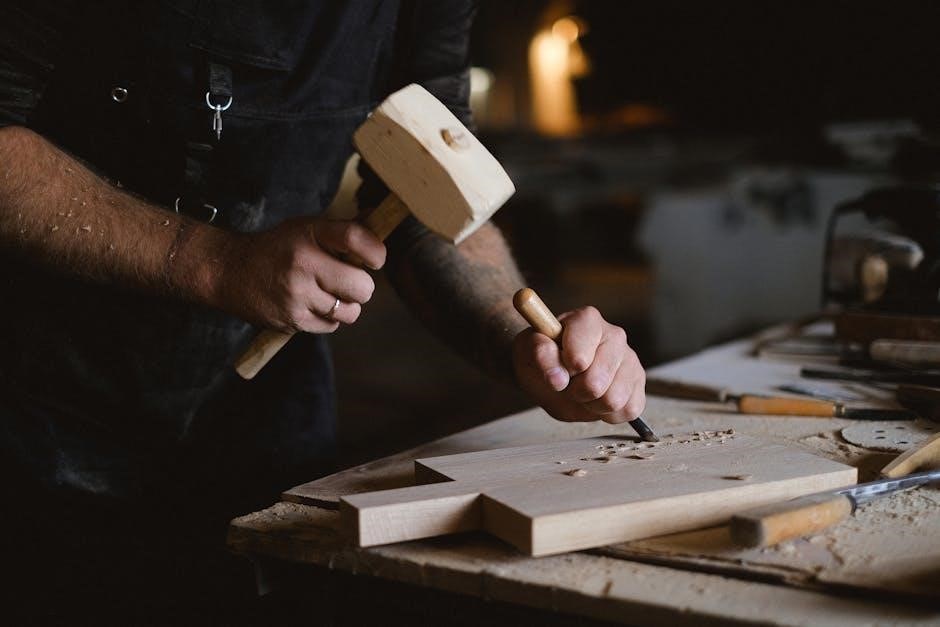A wooden mallet is a versatile and durable tool essential for woodworking, offering precise control and protection for materials․ Crafted from hardwoods like beech or walnut, it combines functionality with personalization, making it a joy to create and use for various projects․

Benefits of Using a Wooden Mallet
A wooden mallet offers exceptional durability and control, making it ideal for woodworking and joinery tasks․ Unlike metal mallets, it provides a softer strike, reducing the risk of damaging surfaces․ The natural grip of the handle enhances comfort during prolonged use, while the balanced weight ensures precise strikes․ Wood mallets are also customizable, allowing craftsmen to tailor the design to their preferences․ They are essential for furniture making, chopping mortises, and other precision tasks․ Additionally, wooden mallets are cost-effective and can be crafted from readily available materials, making them a practical choice for both professionals and DIY enthusiasts․ Their timeless design and personalization options make them a cherished tool in any workshop․

Materials Needed
To craft a wooden mallet, you’ll need durable materials like hardwoods such as beech, walnut, or maple for the head, and a sturdy wood like maple or oak for the handle․ Hard plywood is also a viable option․ For added strength, epoxy resin can be used to inlay designs or reinforce the handle․ Wood glue is essential for bonding the handle to the head․ Sandpaper is required for smoothing surfaces, and a finish like oil or wax protects the wood; Optional materials include metal rings or wedges for added durability․ Ensure all materials are dry and properly prepared before assembly․ These components combine to create a functional and long-lasting tool tailored to your woodworking needs․

Tools Required

Creating a wooden mallet requires a set of essential tools to ensure precision and quality․ A bandsaw or hand saw is necessary for cutting the wood into the desired shape and size․ A drill press or hand drill will help create holes for the handle or any additional features․ Sanding tools, such as a belt sander or sandpaper, are crucial for smoothing the surfaces․ A lathe can be used for shaping the handle, though it’s optional․ Clamps are needed to secure the handle while gluing․ Measuring tools like a tape measure and square ensure accuracy․ Safety gear, including gloves and goggles, is vital for protecting yourself during the process․ These tools will help you craft a durable and functional mallet tailored to your woodworking projects․

Step-by-Step Guide
This guide outlines the process of crafting a wooden mallet, from planning and cutting to shaping, assembling, and finishing․ Each step ensures a durable, personalized tool for woodworking projects․
5․1 Planning and Measuring
Planning and measuring are critical steps in creating a wooden mallet․ Start by selecting the right materials, such as hardwoods like beech or walnut, and consider the mallet’s intended use; Measure and mark the dimensions for both the head and handle, ensuring they align with your project’s needs․ Use templates or PDF plans to guide your measurements, especially for intricate designs like tapered or glued handles․ Double-check all dimensions to avoid errors during cutting․ Proper planning ensures a balanced tool, while accurate measuring guarantees a professional finish․ This step is essential for both beginners and experienced woodworkers, as it sets the foundation for a successful project․
5․2 Cutting the Head
Cutting the mallet head is a precise process that requires careful attention to detail․ Use a bandsaw or hand saw to cut the head from your selected hardwood, such as beech or walnut, ensuring it matches the dimensions outlined in your PDF plans․ For a dead blow design, you may cut the head slightly oversized to allow for drilling and filling with inert material․ If using plywood, cut multiple layers to the same size for a durable and balanced head․ Sand the edges to remove any splinters or rough spots․ Consider using a template to achieve consistent results, especially for intricate shapes․ Always wear safety goggles and maintain a firm grip on the material during cutting․ Accurate cuts here ensure a professional finish and optimal performance of your mallet․
5․3 Shaping the Handle
Shaping the handle is a critical step that ensures comfort and functionality․ Use a lathe or hand tools to craft the handle from durable materials like maple or walnut․ For a tapered design, carefully narrow one end to fit snugly into the mallet head․ If using a glued design, ensure the handle’s dimensions match the head’s cavity․ Sand the handle thoroughly, starting with coarse grit and progressing to fine grit for a smooth finish․ Consider personalizing the shape to fit your hand comfortably; For added strength, apply a small amount of wood glue before inserting the handle into the head․ Once fitted, allow the glue to dry completely․ A well-shaped handle enhances control and reduces fatigue during use, making it a key component of a high-quality wooden mallet․
5․4 Assembling the Mallet
Assembling the mallet requires precision to ensure a secure and durable bond between the head and handle․ For a tapered design, apply wood glue to the narrowed end of the handle and gently tap it into the head until fully seated․ If using a glued design, spread adhesive evenly inside the head’s cavity before inserting the handle․ Align the handle carefully to avoid crookedness․ For added strength, some plans suggest using epoxy, especially for epoxy inlaid designs, where resin fills gaps and hardens for a rigid bond․ Once assembled, clamp the mallet firmly and let it dry according to the adhesive’s instructions․ Proper alignment and a secure fit are crucial for the mallet’s performance and longevity․ Allow the assembly to cure completely before use to ensure maximum durability․
5․5 Sanding and Finishing
Sanding and finishing are crucial steps to ensure the mallet is smooth, durable, and ready for use․ Start by sanding the entire mallet, including the head and handle, using progressively finer grits of sandpaper (80-120-220 grit) to achieve a polished surface․ Pay special attention to edges and corners to prevent splinters․ Once sanded, apply a finish such as linseed oil, beeswax, or a food-safe wood sealant to protect the wood and enhance its appearance․ Allow the finish to dry completely according to the product’s instructions․ For added protection, a clear wax coat can be applied and buffed․ A well-finished mallet not only looks professional but also ensures a secure grip and long-lasting performance․ Proper sanding and finishing are essential for both functionality and aesthetics․
Design Variations
Wooden mallets offer diverse designs, including tapered handles for a snug fit, glued handles for durability, epoxy inlays for aesthetics, and dead blow designs for shock absorption․
6․1 Tapered Handle Design
The tapered handle design is a popular choice for wooden mallets, offering a secure and comfortable grip․ This design features a handle that narrows slightly as it approaches the head, ensuring a snug fit without the need for adhesives․ The tapered shape allows for easy removal and reinstallation, making it ideal for craftsmen who prefer a tool that can be easily customized or replaced․ Additionally, the tapered design distributes weight evenly, enhancing balance and control during use․ Many DIY plans and PDF guides highlight this method, providing detailed measurements and templates to achieve a precise fit․ This design is both practical and timeless, appealing to woodworkers of all skill levels․
6․2 Glued Handle Design
The glued handle design is a straightforward and durable method for constructing a wooden mallet․ This approach involves attaching the handle to the mallet head using a strong adhesive, such as wood glue, creating a permanent and secure bond․ The handle is typically shaped to fit snugly into a recessed area in the head, ensuring stability and preventing movement over time․ This design is favored for its simplicity and strength, making it ideal for heavy-duty use․ Many PDF plans and woodworking guides include detailed instructions for this method, often recommending specific materials and techniques to ensure a lasting connection․ The glued handle design is both practical and reliable, offering a robust solution for craftsmen seeking a dependable tool․
6․3 Epoxy Inlaid Design
The epoxy inlaid design is a modern and visually striking method for crafting wooden mallets․ This technique involves embedding epoxy resin into recessed areas of the mallet head or handle, creating a durable and eye-catching finish․ The epoxy adds strength and resistance to impact, while also offering a unique aesthetic appeal․ Many woodworking plans and PDF guides highlight this method for its ability to combine functionality with artistry․ The process typically involves carving a design or pattern into the wood, filling it with epoxy, and allowing it to cure before sanding and finishing․ This design is particularly popular among woodworkers who want to add a personal touch to their tools․ The epoxy inlaid design ensures a long-lasting and visually impressive mallet that stands out in any workshop․
6․4 Dead Blow Design
The dead blow design is a popular variation of wooden mallets, known for its ability to deliver powerful, controlled strikes with minimal rebound․ This design typically features a solid hardwood head paired with a durable handle, creating a balanced tool ideal for heavy-duty tasks․ The dead blow mallet is often recommended for woodworking projects, as it provides the force needed for driving joints or fitting parts without damaging the material․ Many PDF plans highlight this design for its simplicity and effectiveness, making it a great option for both experienced woodworkers and beginners․ The combination of a sturdy head and a well-crafted handle ensures longevity and performance, making the dead blow mallet a versatile addition to any workshop․

Safety Considerations
Always handle wooden mallets with care, storing them in dry places to prevent damage․ Wear protective gear like gloves and goggles during use to ensure safety․
7․1 Handling and Storage
Proper handling and storage of your wooden mallet are crucial to maintain its durability and performance․ Always grip the handle firmly, avoiding strikes that could cause splintering․ Store the mallet in a dry, cool place to prevent warping or moisture damage․ Keep it away from direct sunlight and children to ensure safety․ After use, clean the mallet with a soft cloth to remove dirt or debris․ For extended storage, consider wrapping the head in a protective cloth or placing it in a protective case․ Regularly inspect the handle and head for signs of wear or loosening, addressing any issues promptly to prevent accidents․ By following these guidelines, your wooden mallet will remain a reliable tool for years to come․
7․2 Protective Gear
When using a wooden mallet, wearing appropriate protective gear is essential to ensure safety․ Always wear safety goggles to protect your eyes from flying debris or splinters․ A pair of sturdy gloves can provide a secure grip and prevent blisters or injuries from repeated strikes․ Additionally, consider wearing a dust mask, especially when sanding or shaping wood, to avoid inhaling dust particles․ Keeping loose clothing or long hair tied back can prevent accidents caused by entanglement․ Proper footwear, such as closed-toe shoes, is also recommended to protect feet from dropped tools․ By prioritizing protective gear, you can minimize risks and enjoy a safe woodworking experience with your handmade mallet․
Personalization Tips
Engrave your name or design for a personal touch․ Customize handles for better grip and style․ Add finishing touches like oil or wax for enhanced durability and appearance․
8․1 Engraving
Engraving your wooden mallet adds a personal touch and enhances its uniqueness․ Use a wood burning tool or CNC machine for intricate designs or text․ Start by sketching your design on paper, then transfer it to the mallet using graphite paper․ For a professional finish, engrave before applying the final coat of oil or wax․ Keep designs simple for better visibility, especially on textured wood․ Consider adding your name, initials, or a meaningful date to make it truly personalized․ Hardwoods like walnut or maple work best for engraving due to their smooth grain․ Practice on scrap wood first to ensure your technique is precise․ This step transforms your mallet into a custom, one-of-a-kind tool that reflects your craftsmanship and style․
8․2 Custom Handles
A custom handle for your wooden mallet offers a perfect fit for your hand, enhancing comfort and control․ Choose materials like maple, walnut, or beech for durability and aesthetics․ Consider a tapered design for a secure grip or a straight handle for simplicity․ Measure your palm to ensure the handle length and thickness suit your preference․ Use sandpaper to smooth the wood, ensuring a comfortable feel․ For added strength, apply a food-safe oil or wax finish․ Personalize the handle with engravings or paint for a unique touch․ A well-crafted handle not only improves functionality but also makes the mallet a one-of-a-kind tool․ This step allows you to tailor the mallet to your specific needs, making it both practical and visually appealing․
8․3 Finishing Touches
The final step in creating your wooden mallet is applying a protective and aesthetic finish․ Start by sanding the entire mallet to a smooth surface, ensuring no splinters remain․ Apply a food-safe oil, such as linseed or tung oil, to protect the wood and enhance its natural beauty․ For added durability, a wax finish can be applied after the oil has dried․ If you’ve incorporated an epoxy inlay, ensure it’s fully cured and sanded flush with the surrounding wood․ Consider adding a coat of clear varnish for extra protection․ Allow the finish to cure completely before using the mallet․ These finishing touches not only extend the life of your tool but also make it visually appealing, turning it into a professional-grade instrument for your woodworking projects․

Where to Find the Best PDF Plans
Discovering the best PDF plans for a wooden mallet is straightforward, with numerous resources available online․ Woodworking websites, forums, and marketplaces like Etsy offer a variety of detailed plans․ Many creators provide instant downloadable files in formats such as PDF, SVG, and DXF, ensuring compatibility with different tools and software․ Some plans include step-by-step guides, scaled templates, and material specifications, making the project accessible for both beginners and experienced woodworkers․ Additionally, specialized woodworking stores and blogs often share free or premium plans tailored to specific mallet designs, such as dead blow or epoxy-inlaid models․ These resources are easily searchable and provide everything needed to craft a high-quality wooden mallet from the comfort of your workshop․

Troubleshooting Common Issues
When crafting a wooden mallet, common issues may arise, such as a loose handle or uneven head․ To address these, ensure proper fit and alignment during assembly․ If the handle becomes loose, applying epoxy or wood glue can secure it․ For a head that splits, pre-drilling holes for dowels or using screws can add stability․ Sanding uneven surfaces or edges can improve balance and comfort․ If the mallet head doesn’t fit snugly, adjusting the taper of the handle or using a tighter joint design can resolve the issue․ Regularly inspecting and maintaining the mallet can prevent these problems, ensuring longevity and reliability in your woodworking projects․

Maintenance and Care
Proper maintenance ensures your wooden mallet remains durable and functional․ Regularly clean the mallet with a damp cloth to remove dirt and debris․ Avoid exposing it to moisture or extreme temperatures, as this can warp the wood․ Apply a wood oil or wax to the handle to prevent cracking and enhance grip․ Store the mallet in a dry place, away from direct sunlight․ Inspect for damage periodically and sand rough edges or splinters․ If the handle loosens, tighten it with wood glue or epoxy․ Avoid using harsh chemicals, as they can damage the finish․ By following these care tips, your wooden mallet will remain a reliable tool for years of woodworking projects․
Crafting a wooden mallet is a rewarding project that combines functionality with personalization․ Whether you choose beechwood, walnut, or another hardwood, the result is a durable tool tailored to your needs․ The process allows for creativity, from handle design to finishing touches, making each mallet unique․ With proper care, your handmade mallet will serve as a reliable companion for years of woodworking and joinery tasks․ The satisfaction of creating something with your own hands, combined with the versatility of the final product, makes this project a standout for woodworkers of all skill levels․ By following detailed PDF plans, you can ensure a professional finish and enjoy the pride of owning a custom-made tool․